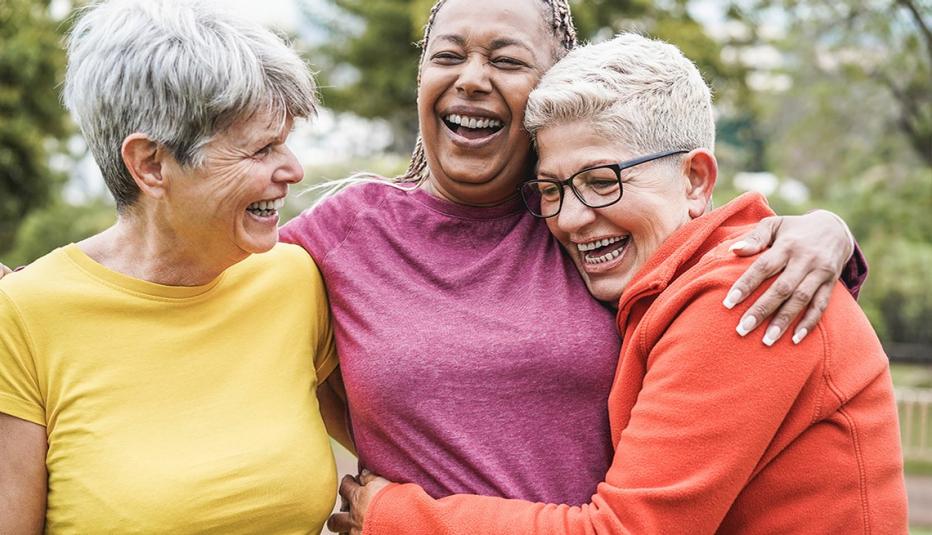AARP Hearing Center
Images can engage audiences by evoking emotions, facilitating memory, and transmitting cultural meaning. In fact, how older people are portrayed in images plays an important role in the implicit messages that are sent through media, advertising, and other communications. Often these channels feature ageist stereotypes, such as being unable to use technology, or exclude older adults altogether.


A 2019 AARP study found that people age 50 and older are significantly underrepresented compared to their younger peers in images appearing in online news and social media advertisements and how older people are represented (or not) conveys implicit messages about them.
To explore the effects of images on explicit attitudes about aging and older people, AARP partnered with Frameworks Institute to conduct a national survey of 3,166 U.S. adults age 18 and over. We exposed participants to one of 13 image categories or a control condition with no images.
The categories were:
- Intergenerational groups
- Same generation groups
- Community setting
- Workplace setting
- Household setting
- Limited mobility and engaged
- Limited mobility and disengaged
- Technologically competent
- Technologically incompetent
- Active older person/people
- Passive older person/people
- “Super senior”
- Alone
After exposure to the images, AARP and FrameWorks Institute fielded an implicit association test (IAT) with 3,153 U.S. adults age 18 and over to measure implicit — or unconscious — attitudes.
The study findings show that aging advocates and communicators should consider not only how aging and older people are framed in writing, but also how they are depicted in images.
When selecting images to improve attitudes about older people and aging, keep in mind the following key insights and recommendations:
Select images that counter stereotypes while maintaining authenticity.
- Women generally express more positive attitudes than men do about older adults and aging, so images that reinforce stereotypes about older adults are particularly harmful for women’s attitudes.
- Images that depict older people in the workplace are particularly important for shifting men’s explicit attitudes toward aging, and they show that older adults are actively contributing to their communities.
Images should depict older adults engaged with others or their surroundings.
- Showing images of older adults with limited mobility who are engaged with their surroundings has more positive effects on both implicit and explicit attitudes toward older adults than showing images of older adults with limited mobility who are disengaged.
- Showing images of older adults engaged in typical activities is more effective at conveying that they are full of life than those showing older adults participating in extreme activities (surfing, skydiving, bodybuilding, etc.).
Use images that depict older adults as competent, confident, and capable.
- Showing images of older people using technology confidently and without assistance can help people recognize that older adults are capable of using technology.
Whenever appropriate, use images that reflect an upbeat mood, in their subjects as well as in their other aesthetic qualities (lighting, setting, etc.).
Use images that depict older people in positive settings and engaged in positive activities.
Conclusion
It’s also important to remember that images are rarely displayed in isolation; they are usually accompanied by text. Past research indicates that text-based frames can be powerful in shifting understanding of and attitudes toward aging — both implicit and explicit.
These findings on images suggest that the right images can help amplify positive changes in attitudes and strengthen those mainly text-based strategies.
Using images strategically to reframe aging is an evolving practice. More research is needed to help us harness the power of images in combating negative stereotypes and fostering positive attitudes about aging and older people.
To see how data from this study can help brands reframe aging, check out our data story, Is Your Brand Missing Out on the 50+ Market?
Suggested citation:
Hestres, Luis E., Jennifer E. John, Abigail Rochman, Andrew Volmert, Colette Thayer, Patty David, Lona Choi-Allum, and Laura Skufca. Reframing Aging Through Images: Recommendations from Research. Washington, DC: FrameWorks Institute and AARP Research, October 2022. https://doi.org/10.26419/res.00546.001




































































